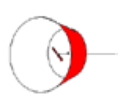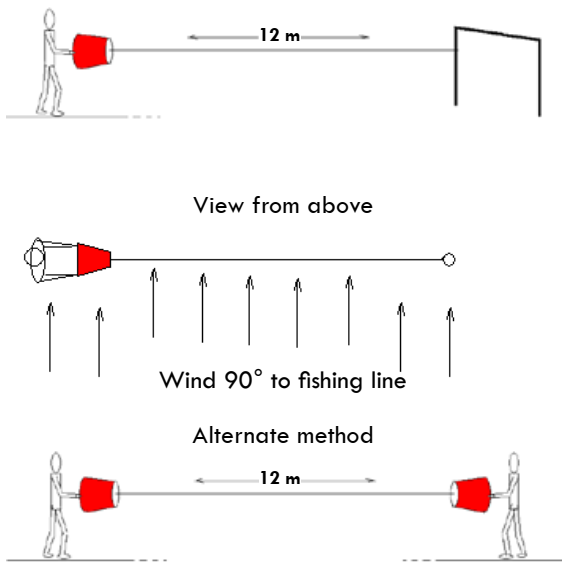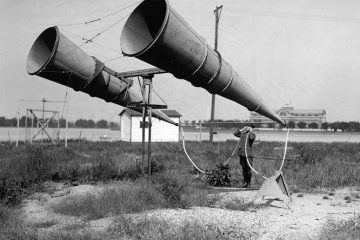A bucket harp
An aeolian harp is driven by wind, so this needs a very windy day and an exposed site to work. Named after the Greek god of the wind, these harps are usually made from a wooden box and strings stretched between two bridges. This activity uses a simpler construction using a bucket, some strong fishing line and a peg.
Method:
- Tie one end of the fishing line to a fixed object such as a tree, a fence or a goal-post. The line must be exposed to the wind on all sides.
- Feed the other end of the fishing line through a hole in the base of a bucket or bin and tie it to a peg inside the bucket to hold the line in place.
- Stand so the line is perpendicular to the wind. Pull the line taught, but be careful not to break it.
- Wait a few seconds for the wind to excite the fishing line. Eventually you should hear strange
- and haunting sounds emanating from the bucket.


An Aeolian harp in the classroom
With a bit of cunning, you can explore the excitation of strings by wind even when it’s not windy. If possible, get hold of a purpose built aeolian harp. It will need a smooth (laminar) flow of air across its strings which you can get by funnelling the air from a domestic fan.
Career link: aeroacoustics
Engineering the noise created as a car moves through air is vital to make a great sounding vehicle. Doing this for the new Continental GT Convertible was challenging but definitely exciting. Reading the reviews once the car was launched was a particular highlight!”
Ben West, Bentley Motors Ltd
![]() Career case study: more about Ben’s job and how he got into acoustics
Career case study: more about Ben’s job and how he got into acoustics
What science students learn
National Curriculum, KS2 Year 4 programme of study:
- Identify how sounds are made, associating some of them with something vibrating
- Recognise that sounds get fainter as the distance from the sound source increases
- Find patterns between the volume of a sound and the strength of the vibrations that
produced it
| In addition: |
- Sound amplification (in this case by the bucket).
- Transfer of energy (from wind to sound).
It also allows exploration of scientific experimentation.
How does the wind play the string?
The motion of the wind across a string causes vortex (swirl) downstream that flips from one side of the string to the other. In the animation below, the white circle is the string and the green and purple stuff the vortexes. The alternating vortex causes the string to vibrate up and down (not shown in the animation).

The frequency created by the vortex shedding of the tone is given by the following equation:
f=\frac{0.2u}{d}where d is the string diameter and u the speed of the wind. This then excites any string harmonics that are at a similar frequency [1]. When you pluck the string of a guitar the loudest sound is normally the fundamental. But when the wind blows across the harp string you normally hear a much higher note, a harmonic of the fundamental note. As the wind blows, the tension changes, and this alters the frequencies of these harmonics, producing some interesting sound effects.
Why does the harp make such eerie sounds?
It is unusual to have a musical instrument where the sound waxes and wanes depending on air speed, which is one reason it sounds unusual. The changes in pitch and amplitude are unlike any other instrument.
What does the bucket/bin do?
The string itself has a very tiny surface area so it doesn’t move much air (indeed, it’s the air that’s moving the string in this case). By itself, the string makes a tiny sound, but because the string is attached to the bucket, the vibrations pull on the base of the bucket and make it vibrate the same way. The bucket has a large surface area and so it pushes a lot of air and makes a big sound. What makes the effect even stronger is that the volume of air in the bucket also resonates. This is very similar to how a the sound of a string is amplified by the body of an acoustic guitar.
Acknowledgements
Resource by Luke Jerram, Salford and Southampton Universities.
[1] Selfridge, R., Moffat, D., Reiss, J. and Avital, E., 2017. Real-time physical model of an Aeolian harp. 24th International Congress on Sound and Vibration.

1 Comment
Paulo Guilherme Delorenci Toscano Costa · September 6, 2021 at 1:35 pm
I loved this content. My name is Nasnuven Paulo and I’m for a long time interested in aeolian harps. Some years ago I almost developed one, at the college I already graduated. Nowadays I’m planning to do something about it. Restarting my researches, in here i found leads for it. Thanks for the contribution, by the way. I’d love to know more about. Could you recommend any bibliography about the theme? I use to love any content that talks about sound, acoustic, cymatics, physics, etc. Best wishes, Paulo.